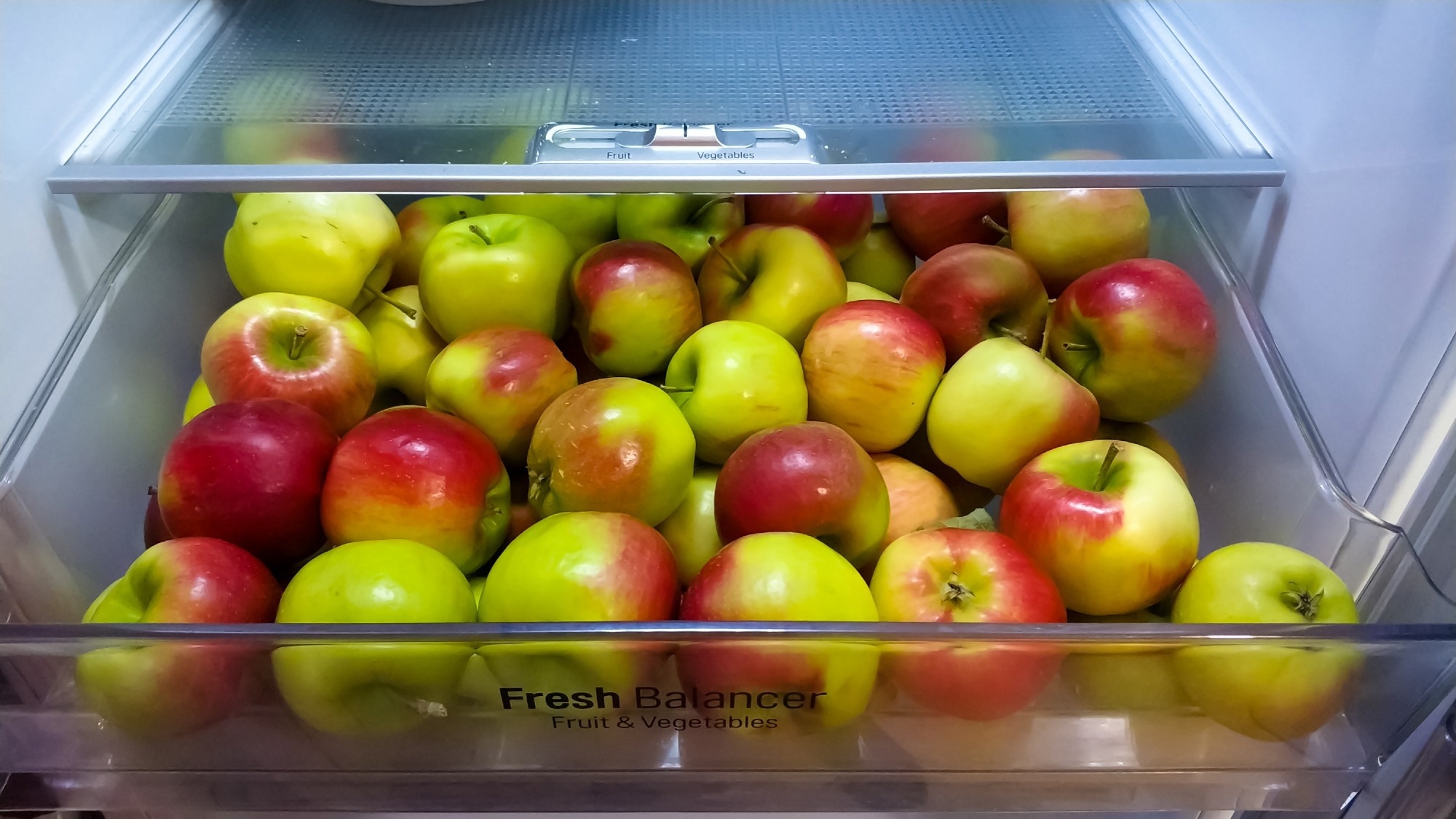In a recent review published in the journal Foods, researchers collated available literature on edible coatings and their potential in the food industry. Their research highlights how these biopolymer-based coatings can present ideal alternatives to preservatives and conventional plastic packaging materials in preserving foods, especially perishable ones like fresh fruits and vegetables. This review covers details about the various types of edible coatings currently under study, how they are formulated and produced, and their potential applications in the future.
Review: Edible Coatings as a Natural Packaging System to Improve Fruit and Vegetable Shelf Life and Quality. Image Credit: Endless luck / Shutterstock
The need for new-generation food preservation
Research into the adverse health outcomes of food preservatives and the consumer awareness this has achieved has caused a shift in the market wherein fresh and ‘organic’ food products are increasingly being preferred over their more processed counterparts. With the public becoming increasingly aware of the effects of anthropogenic pollutants on the environment, food companies are now faced with a dilemma regarding the reduction of plastic waste while also having to extend the shelf life for rapidly perishable fresh foods as a result of this shift.
While biotechnology has offered the alternative of genetically modified crops with improved shelf lives, genetic engineering can only go so far in enhancing the duration that fruits and vegetables remain palatable, let alone fresh. Increasing demand in developed countries for ‘organic’ fresh foods, many of which are exotic and imported from foreign countries, is forcing the food industry to explore alternatives that can prevent food spoilage via oxidation, microbial contamination, or sensory characteristics deterioration while still not adding to the existing plastic overload that landfills the world over experience.
Recent research has suggested that edible coatings might provide the solution that the food industry seeks. Edible coatings are biopolymer-based films directly applied to the surface of foods to form a protective barrier (primary packaging) against the adverse effects of environmental exposure. These eco-friendly films are qualified as being safe for human consumption while also satisfying the requirements of preservation (oxygen and carbon dioxide permeability) and sensory properties (should be transparent, tasteless, and odorless). Depending on their formulation, edible coatings may present the added advantages of enhancing the sensorial properties of the foods they protect or improving their biochemical, physicochemical, and microbial stability.
Based on their composition, biofilms are broadly classified into three types – hydrocolloids (composed of polysaccharides and lipids), lipids, and combinations of both. Additionally, some edible coatings contain inorganic nanoparticles (NPs), essential oils (EOs), and other elements to address specific food needs.

Film formulation and application processes
Casting and extrusion are the two most commonly used and widely studied methods for film formation. Casting is a three-step process wherein a biopolymer is first dissolved in a non-toxic solvent, subsequently cast in a mold, and then dried. Given the cohesive particle-particle interaction, this method produces casting results in a homogenous edible film. Casting presents a low-cost method of film production without the need for specialized manufacturing equipment. Unfortunately, given the need for both a solvent and a mold, casting is inherently time-consuming, limited to the production of only sheets and tubes, and prone to solvent-induced protein denaturation, limiting its use to laboratory research and pilot industrial application.
Unlike the ‘wet,’ solvent-using casting process, extrusion is a dry method involving a direct mixture of biofilm components, which are then compressed at high temperatures and pressures. It alleviates the demerits of casting, being a fast and energy-efficient process with the potential for incorporating a wide range of constituent components. Its demerits are the requirement of expensive, specialized equipment that require frequent maintenance, restricting its use to large-scale industrial application.
Hitherto, three main methods of extrusion coat application have been devised – dipping, spraying, and vacuum impregnation. Spraying is the oldest and most often used. As the name implies, a biopolymer formulation is sprayed on all food product surfaces. While this ensured homogeneous packaging, the spray may not even result in wastage of the biopolymer and a net reduction in the nutritional value of the preserved food. In the dipping method, the food is dipped in the coating solution for 5-300 seconds, following which any excess solution is drained. This method guarantees an even coat on all food surfaces, with minimal wastage of film components.
Vacuum impregnation is a novel method that follows dipping. After the food product has been dipped, it is subjected to extremely low pressure, which wicks away residual air and introduces the ‘vacuum’ state, increasing shelf life.
Film constituents
Polysaccharides are the most commonly used of the various macromolecules used in edible coatings. This group is characterized as being efficient O2 and CO2 barriers, but given their hydrophilic nature, poor moisture barriers. Chitosan (CH), derived from chitin, starch, pectic, alginate, and cellulose, are commonly used polysaccharides, though they are usually combined with other compounds to alleviate their moisture retention demerits.
Protein-based edible coatings are the next major group of films, with benefits derived from their gas-resistant properties and their potential use as direct protein supplements to the food products they are coating. Whey, soy, gluten, and zein corn are commonly used proteinaceous edible coating constituents that are increasingly being researched for their potential to be recycled within the food industry.
Lipids form the final major group of conventionally used biomolecules for film production. Lipids generally have the best moisture- and oxidation-resistant properties of any of the aforementioned film constituents. However, their high hydrophobicity results in their films being comparatively far more brittle than either polysaccharides or proteins. They usually need to be applied in thick coats, which, while non-toxic, need to be removed or peeled off prior to food consumption. Paraffin wax was one of the first used constituents of edible coats and remains the most popular lipid film constituent used today.
Essential oils (EOs) are aromatic compounds derived almost ubiquitously from plant extracts. These oils are selected for their sensory-enhancing (odor) and hydrophobic properties. EOs are rarely used in isolation but are often found as additives in films primarily composed of polysaccharides, proteins, or lipids. Recently, research has begun focusing on identifying EOs with the additional benefit of having intrinsic antimicrobial properties and their applications as natural preservatives that can prolong food shelf life.
“Nanoemulsions are oil-in-water or water-in-oil solutions that can be used for edible coating formulations to improve their physicochemical properties. Oil-in-water nanoemulsions are more suitable for this application since they can be easily fused with food-grade components, allowing a better scaling-up process. Oil-in-water nanoemulsions are considered the next-generation edible coatings since they can be fused with food-grade components, allowing more scope for the scaling-up step in the industry by applying a homogenization approach.”
Bio-nanocomposites are novel film constituents that incorporate inorganic nanoparticles (NPs), nanofibers, and nanofillers in various combinations and film thicknesses to achieve the desired degree of air and moisture resistance. Some of these compounds have been shown to improve the mechanical properties and thermal resistances of the primary polymer-based film component. NPs are nano-scale solid colloidal particles that are stable, functional, and biologically active. Most of these colloids are chosen for their antimicrobial characteristics, substantially improving food shelf life.
Food By-Products as Materials for Edible Coating Formation
All edible coatings currently used in the food industry use at least one natural macromolecule to act as the base biopolymer – a polysaccharide, lipid, or protein. Most, if not all, of these can be directly obtained from by-products of the food processing industry, especially during the harvesting of food crops.
Large-scale industrial and scientific research is exploring the possibility of deriving all coating components from food production by-products or recycled lipids, which, if successful, would contribute substantially to edible packaging efficiency and sustainability. In this manner, food wastage and the environmental impacts of the food-processing industry would be minimized.
Conclusions
The current research summarized previous literature on edible coatings, focusing on their composition, formulations, application, and relative pros and cons. When the specific resistance requirements of the food products are optimized for, both industrial and scientific data agree that edible coatings significantly prolong the shelf life of perishable food items without the need for conventional, potentially toxic preservatives. Edible coatings have been shown to improve the physiochemical and sensory appeal of their encapsulated foods, further suggesting their benefits.
“Edible coatings are a suitable alternative to traditional plastic packaging that is being widely studied nowadays, especially for perishable products such as fruits and vegetables. The need for food waste reduction, the consumers’ interest in incorporating more fresh products in their diet, and the awareness of society about the environment are key points and the main reasons why edible coatings are receiving so much interest from the scientific community. The data collected about edible coatings show that this pathway should be considered by the food industry, not only for the advantages from the point of view of the prolongation of perishable products’ shelf-life but for the possibility of using other food by-products, such as pectin and chitosan, as biopolymers for coating formulations.”











